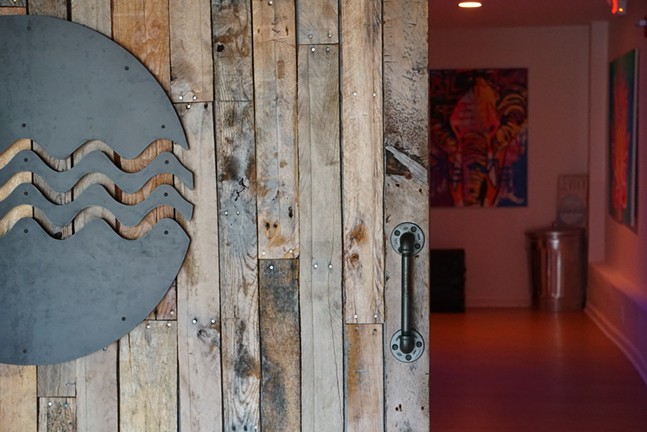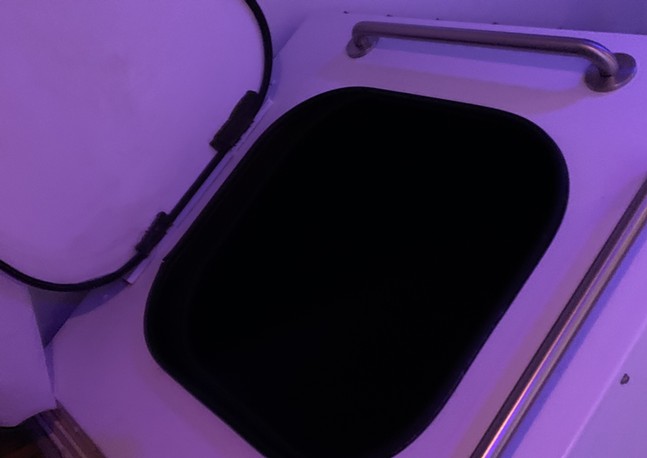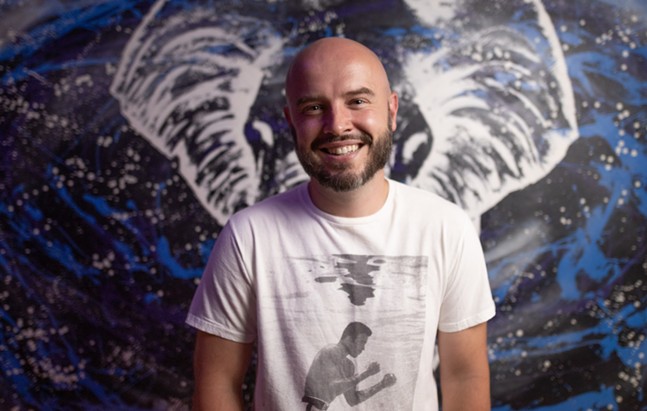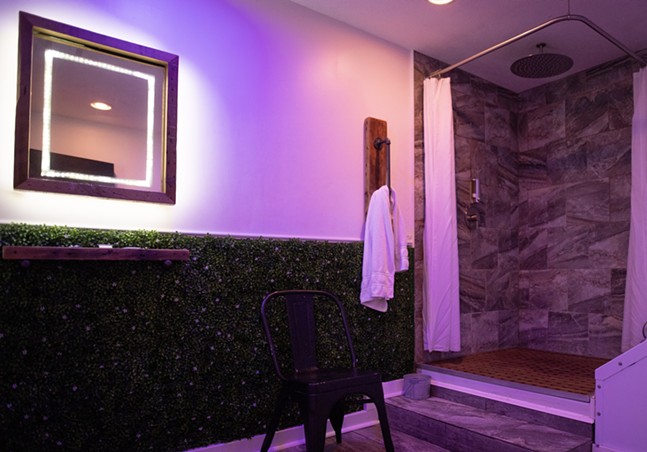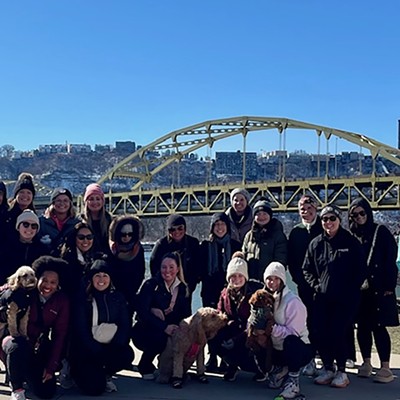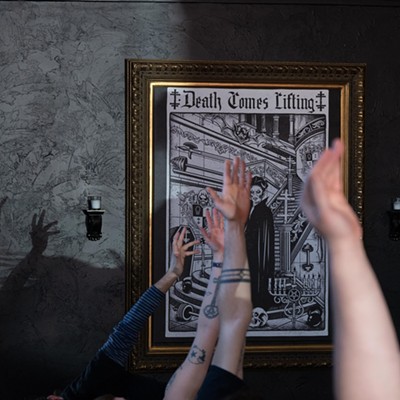Walking into Levity Float Studio, a nondescript glass storefront on Murray Avenue, you might think you’d stumbled into a yoga studio, a therapist’s office, maybe even a coffee shop. Soothing string music plays in the lobby with comfy chairs, lit candles, a salt lamp, and tea from Dobrá Tea, a vegetarian restaurant and cafe located up the street (its owner is also a studio regular).
But what the space offers is more ethereal, benefitting “body, mind, and soul,” according to Levity’s website. Behind a sliding barn door are two float tanks, pods filled with heavily salted water (1,200 pounds of Epsom salt, to be exact), making the water in the tank three times denser than the Dead Sea. Studio clients climb (clothed or unclothed) through what looks like a spaceship hatch, only to be enclosed in near or total darkness, where they then float in a foot of “skin-temperature” water, experience weightlessness, and, reportedly, deep relaxation.
The set-up is also referred to as an isolation tank or sensory deprivation chamber, though many eschew that term due to its negative connotations and also because — as several enthusiasts told Pittsburgh City Paper — they could just as easily describe their experience as sensory enhancement. Floating, or floatation therapy, is an alternative wellness practice that originated nearly 70 years ago, but it’s experienced something of a renaissance in the last decade. The purported benefits are many: physical therapy and pain relief from the reduced gravity; meditation from the limited light and sound; even consciousness exploration or psychedelic experiences.
Levity is among Pittsburgh’s first float studios, established nine years ago. The same year, the first-annual State of the Float Industry Report was released, promising a wide open market appealing to city dwellers and suburbanites alike.
Starting a float studio in Pittsburgh then was a challenge, David Rapach, Levity’s owner, remembers.
“If you could imagine the look on a banker’s face,” he laughs. “They weren't having it. It wasn’t around here. It was very West Coast. It was very holistic. It was woo-woo and hoity-toity, like, oh, that's something that’s not for Pittsburgh. And I just kept the vision of, yes, it is for Pittsburgh.”
Today, it seems float studios are opening up all over the region, with options in Lawrenceville, Shadyside, and the North Hills. True REST (Restricted Environmental Stimulation Therapy), a float spa franchise, expanded locations to the South Hills and Washington County.
Rapach reports that Levity serves a solid roster of repeat guests, as he calls them, and “rookies.” Guests are all ages — ranging from Rapach's seven-year-old daughter to 82 — and from all walks of life.
“These are hardworking people, young professionals, parents, retirees,” Rapach, an Indiana, Pa. native, says. “Pittsburgh is known for that grittiness, Rust Belt feel of going to work, blue collar, and also the tech world. There’s so many people that need a break.”
Among the regulars are a couple working in the fast food industry and tech employees who are offered float vouchers by their companies.
Guests can float while pregnant and for postpartum recovery. It’s common to hear your own heartbeat in the quiet of a float tank, but once, Rapach recalls, an expecting guest heard her baby’s heartbeat for the first time — and “she felt this connection.” He gets choked up describing it. “To see a future mother teary-eyed and just glowing, oh!”
Levity has even seen its share of professional athletes: Steelers Cameron Heyward, Troy Polamalu, Bud Dupree, and Antonio Brown have all floated.
Clients who float regularly (“floaters” makes for a dicey term given the CSI associations) tend to become evangelists, introducing family and friends to the affecting experience of “the tank.”
Destini Thompson, 23, began floating six years ago as a teenager when a friend brought her to the studio. She suffers from chronic pain and experienced stress from a demanding job. She has since brought her mother, who finds floating provides relief from migraines.
“I found Levity searching for that one place in the busy world where things stop for a second,” Thompson says.
It’s a constant refrain in the float community: the tank is a necessary escape from the everyday hustle and bustle, the sense of being overwhelmed — even by, simply, our phones. In 2021, the New York Times went so far as to say the rise of the float studio represented a literal manifestation of a “desire for nothingness … to reject the overstimulation that defines contemporary existence.”
“The important thing I always try to remind people is try to give yourself the grace to relax and let yourself be,” another frequent float guest, Joshua Hamaker, advises. “You need small healthy breaks from all of the sensory overload going on around us.”
A typical beginner float lasts one hour, the thought of which can give the uninitiated anxiety.
“Time is strange, right?” Thompson explains. “You [think], oh, it's six o'clock, I gotta eat dinner. Well, six o'clock doesn't exist in the tank. The only thing that exists is that moment.” Constructs of time and space reportedly begin to erode, which for some is part of the attraction.
Phil Seth is a Pittsburgh artist and “self proclaimed endonaut, an inner traveler of the vast cosmos within each of us.” While most float clients seek to destress — Seth calls floating a “cheat code to meditation” — he also falls in with those chasing visualizations in the tank. The effect is similar to that of lucid dreaming or psychedelic drugs —“a night at the movies,” Seth says, but “without having to intake anything.”
His first float was around eight years ago, and with practice, he began seeing animals drifting in space. The first was a golden, glittering butterfly batting its wings in the darkness, which inspired him to paint. He’s since developed a series of Floating Dream Prints, which hang at Levity. Rapach also allowed Seth to float at midnight “into” his birthday, on a full moon, leading to a lunar-themed painting.
Seth speaks briskly about the numerous benefits of floating, how in his daily life he can imagine himself in the tank, lower his heart rate, and step “back into that cosmic stream.”
Like many float devotees, he believes there could be a float studio on every corner, and it might not be enough to combat the stress and noise. The only danger, Seth and others say, would be McDonaldization of the industry, making the experience quick and impersonal. "It seems so counterintuitive to our Westernized capitalist run, run, run… [that] really one of the most beneficial things we can do right now is just stop doing anything."

